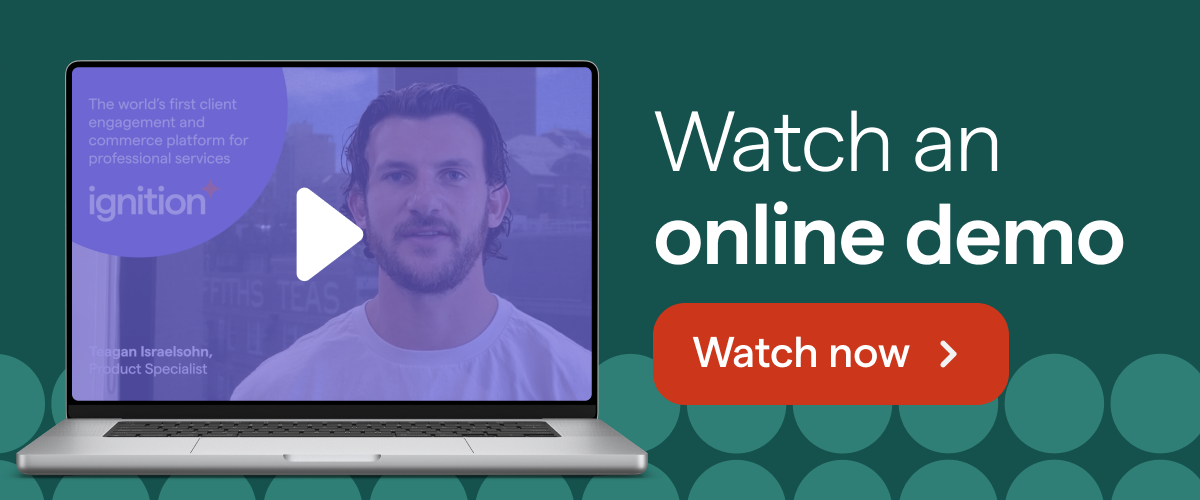Client engagement checklist: 6 things you must do to find and retain clients

There's no shortage of articles telling service providers how they can acquire customers. But acquisition is only half of the battle; once you have your customers, you need to find a way to keep them.
This is where client engagement comes into the picture. By keeping client engagement high, your company can fuel more profitable business activities and long-term customer retention that enables successful growth.
There's a variety of strategies open to professional service providers to help them leverage engagement effectively. In this post, we're going to cover what client engagement is, why it matters, and 6 strategies for helping you to find and retain clients this year and beyond.
What exactly is 'client engagement'?
Client engagement refers to the interactions that take place between a business and its customers. Interactions can stem from email communications, a real-time chat tool helping clients to troubleshoot problems, or your brand's digital marketing efforts, just to name a few.
Both current and prospective customers will be engaging with your business throughout the customer lifecycle. However, the quality of client engagement can vary significantly.
If a customer likes one of your social media posts, this is a fairly superficial form of engagement compared with them clicking on a link in the post that takes them to your website. Meanwhile, a client who chooses to upgrade their service plan in response to your marketing efforts likely has the highest levels of client engagement.
The purpose of client engagement isn't just to 'touch base' with your client, but to empower them to build a closer emotional connection with your business — both online and offline.
Why client engagement matters
Engaged customers are loyal customers. Customer retention is a tricky business in 2021, when competing service providers are just a Google search away. Unless retention is higher, it's extremely difficult to achieve sustainable business growth. By making an effort to engage your client on multiple fronts, they're much more likely to be invested in your business. According to Bain & Company, a 5% increase in customer retention produces over a 25% increase in profits.
It enables you to upsell your clients. Unless you engage with a client regularly, it's impossible for your business to know whether their current pricing plan is still working for their needs — or whether there may be an opportunity to upsell them onto a plan that brings in higher revenue. By keeping engagement high, clients will be much more receptive to these efforts.
A higher likelihood of client referrals. When customers are happy and engaged, they're much more likely to recommend your business to others. Not only do client referrals lower your acquisition costs; referrals are also much more likely to stay loyal. According to Extole, customers acquired via referrals have a 37% higher retention rate than those acquired using other strategies.
6 client engagement steps you can take to find and retain clients
1. Upsell your services with proposals
Writing a professional service proposal is one of the most important parts of the acquisition process. This makes it one of your foremost opportunities for client engagement during the customer journey.
Proposals are a key customer touchpoint for warm leads who are interested in your business and want to know more about the benefits of your services. Proposals can also be used when an existing customer is wanting to new their service agreement and/or investigate other companion services.
To increase client engagement, you need to make the process of reviewing and accepting proposals as frictionless as possible. If your proposal is well-executed you'll not only gain a new client, but maybe even upsell them onto a higher-level pricing plan or subscription.
With Ignition, professional service businesses can easily generate proposal templates that enable prospective customers to select different service and payment options within documents — no additional paperwork required.
2. Send regular engagement letters
Engagement letters are a crucial tool for professional service providers to start off the customer relationship on a good note. Simply put, an engagement letter is a document that sets out the terms of doing business with your firm. The specifics will vary depending on the service, but will usually cover the following:
The service(s) being provided
Who is providing the service
The schedule of service
How much is being charged
Legislation that the service is operating in accordance with
In sum, engagement letters are a critical component of the client experience that helps to establish expectations and trust in the service provider.
While it isn't necessary for a provider to send engagement letters on a regular basis (once annually is a common practice) they're a highly useful tool for client engagement. Sending a bi-annual or quarterly engagement letter is the perfect opportunity to see whether the service is still working for your customer and how else you may be able to help.
3. Ensure a smooth onboarding process
A successful onboarding process is about far more than showing your customer the ropes; it's your first opportunity to make a good impression after a conversion.
When done well, onboarding reinforces that your customer has made the right decision. But if it goes poorly, they're going to start looking for alternatives. In fact, 86% of people say they’re more likely to stay loyal to a business that invests in the onboarding experience.
So, by investing in onboarding as a client engagement strategy, you can enhance the brand experience and improve customer retention.
Ultimately a smooth onboarding is all about setting expectations, from admin processes i.e. deciding who is the main point of contact to understanding what your clients want to achieve by using your services.
4. Invest in content marketing
Content is a vital but often neglected element of your customer engagement strategy. The purpose of content marketing is to provide customers with relevant and timely content that showcases your brand and enhances their experience with your services.
For example, a company blog can be a helpful resource for industry information and upcoming trends/changes that could affect your clients’ businesses. Meanwhile, webinars or podcast series that host knowledgeable guests help to boost your value proposition and give customers additional reasons to choose you over competing service providers.
By disseminating this content with the likes of email, social media, and push notifications, you can pioneer a powerful omnichannel engagement strategy. According to the Content Marketing Institute, 56% of Australian marketers say that social media is the most effective channel for content marketing campaigns. By leveraging customer data, you can make recommendations as to what content your customer will be interested in, a tactic that built Netflix into one of the top streaming services globally.
Accounting software Xero has done a great job at building a blog that covers a variety of topics that are of interest to their target audience. By putting product updates and educational resources in the same place, Xero has created a one-stop shop that adds value to customer interactions and strengthens their service offering.5. Reward your most loyal clients
It's well-known in business that around 20% of your customers represent 80% of your billable activities. This 20% will be the most receptive to your engagement marketing efforts, which also makes them the best target for loyalty initiatives.
While you don't need to have a full-blown loyalty program in place, offering incentives that reward positive behaviors is a great way to build customer loyalty and client engagement.
For example, if a client has been signed up with your service for six months, you could offer a discount off their next month as a thank-you. Alternatively, you can reward specific behaviors, such as making a successful referral or writing a review. These initiatives help to forge a stronger emotional connection with your brand and encourage higher customer retention.
6. Ask for feedback
If you're looking more for effective customer engagement methods, one of the best strategies is to simply ask your clients.
Running regular customer surveys enables your business to be proactive in measuring customer satisfaction and asking how you can offer stronger customer support. Moreover, it's a great way to show that you care about their experience.
There's a variety of survey types you can use to obtain customer feedback. One of the most straightforward is the Net Promoter Score (NPS) which asks your customers a single question on a sliding scale from 1-5. For example, asking customers "how would you rate your experience using our services?" gives you a great overview of how your customers feel about your current engagement activities.
How to measure client engagement
If you're aiming to increase client engagement, it's important to measure it so you know whether your efforts are bearing fruit. Here are some customer engagement metrics that can form the basis of KPIs for service providers:
Client referrals. Word of mouth is one of the powerful marketing tools, resulting on average in 5x more sales than paid ads. As we covered earlier, it's a good idea to offer incentives to keep referral traffic as high as possible.
Average time spent on site/page. If clients are spending a lot of time on your website checking out resources, they're clearly interested in exploring your services further than what they've already paid for. You can check these metrics with the use of free tools such as Google Analytics.
Churn rate. If customers are deserting your business mid-lifecycle, this can indicate a variety of different problems - including a poor engagement rate. By keeping a close eye on customer churn, you can see whether or not your current efforts are working.
Over to you
Keeping clients engaged and interested in your service offerings is a big challenge, especially when there are so many competitors vying for their attention. But as we said near the beginning of this article, engaged customers are loyal customers. By following the strategies outlined above, your business will be in a much better position to increase customer retention, boost client referrals, and upsell customers onto bigger pricing plans that strengthen your bottom line. In sum, the more clients who are emotionally invested in what you have to offer, the healthier your business will be.
Every professional service provider wants a healthier business and Ignition’s client engagement and commerce platform helps you achieve that. The software comes with everything you need to engage and retain clients. From proposals and engagement letters to client management and billing, Ignition is here to help you build win-win relationships with your clients. Start a free trial today and see how our platform can help your business grow.

